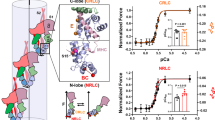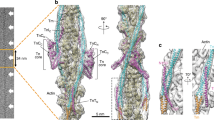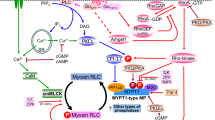Abstract
CYTOPLASMIC myosins are found in most non-muscle cellular systems studied to date1. In vertebrates these myosins are composed of two heavy chains of 200,000 molecular weight (MW) and four light chains, two each of 20,000 and 15,000 MW. A number of cytoplasmic myosins, as well as skeletal, smooth, and cardiac muscle myosin, can be enzymatically phosphorylated2–6. That is, those light chains of MWs 18,000–20,000, the so-called P-light chains6, can undergo phosphorylation catalysed by a myosin light chain kinase7,8. In this reaction the terminal phosphate of ATP is transferred to a specific amino acid residue on the myosin P-light chain, up to one mole of phosphate per mole of light chain9,10. A myosin light chain phosphatase that catalyses the removal of the covalently-linked phosphate group from the P-light chain, returns the myosin to the non-phosphorylated state5,11. Phosphorylation of human platelet myosin4, guinea pig vas deferens3 and chicken gizzard12,13 smooth muscle myosin results in an increase in the actin-activated ATPase activities of these myosins. Although the phosphorylation of the P-light chain of rabbit skeletal muscle myosin has been described10, no functional change in this myosin's activity due to phosphorylation has been demonstrated11. To study the role of myosin phosphorylation during muscle cell differentiation, we investigated precursor cells to skeletal muscle, namely proliferative myoblasts. The Yaffe L-5 810 line of cloned proliferative rat myoblasts is an actively dividing cell line in culture which under the appropriate conditions can form myofibrils. We now report: (1) that myosin isolated from proliferative myoblasts contains light chains of 20,000 and 15,000 MW, (2) the 20,000 MW light chain can be phosphorylated by an endogenous myosin light chain kinase14, (3) the proliferative myoblast myosin light chain kinase does not require calcium ions for activity, and (4) phosphorylation is a pre-requisite for actin activation of the myosin's ATPase activity.
This is a preview of subscription content, access via your institution
Access options
Subscribe to this journal
Receive 51 print issues and online access
$199.00 per year
only $3.90 per issue
Buy this article
- Purchase on Springer Link
- Instant access to full article PDF
Prices may be subject to local taxes which are calculated during checkout
Similar content being viewed by others
References
Pollard, T. D. & Weihing, R. R. Crit. Rev. Biochem. 2, 1–65 (CRC, Cleveland, Ohio, 1974).
Scordilis, S. P., Anderson, J. L., Pollack, R. & Adelstein, R. S. J. Cell Biol. (in the press).
Chacko, S., Conti, M. A. & Adelstein, R. S. Proc. natn. Acad. Sci. U.S.A. 74, 129–133 (1977).
Adelstein, R. S. & Conti, M. A. Nature 256, 597–598 (1975).
Adelstein, R. S., Chacko, S., Barylko, B., Scordilis, S. P. & Conti, M. A. in Contractile Systems in Non-Muscle Tissues (eds Perry, S. V., Margreth, A. & Adelstein, R. S.) 153–163 (North-Holland, New York, 1976).
Frearson, N. & Perry, S. V. Biochem. J. 151, 99–107 (1975).
Pires, E., Perry, S. V. & Thomas, M. A. W. FEBS Lett. 41, 292–296 (1974).
Daniel, J. L. & Adelstein, R. S. Biochemistry 15, 2370–2377 (1976).
Jakes, R., Northrop, F. & Kendrick-Jones, J. FEBS Lett. 70, 229–234 (1976).
Perrie, W. T., Smillie, L. B. & Perry, S. V. Biochem. J. 135, 151–164 (1973).
Morgan, M., Perry, S. V. & Ottaway, J. Biochem J. 157, 687–697 (1976).
Sobieszek, A. Eur. J. Biochem. 73, 477–483 (1977).
Gorecka, A., Aksoy, M. O. & Hartshorne, D. J. Biochem. biophys. Res. Commun. 71, 325–331 (1976).
Scordilis, S. P. & Adelstein, R. S. Biophys. J. 17, 268a (1977).
Chi, J. C., Fellini, S. A. & Holtzer, H. Proc. natn. Acad. Sci. U.S.A. 72, 4999–5003 (1975).
Fairbanks, G., Steck, T. & Wallach, D. F. H. Biochemistry 10, 2606–2617 (1971).
Anker, H. S. FEBS Lett. 7, 293 (1970).
Perrie, W. T. & Perry, S. V. Biochem. J. 119, 31–38 (1970).
Spudich, J. A. & Watt, S. J. biol. Chem. 246, 4866–4871 (1971).
Martin, J. B. & Doty, D. M. Analyt. Chem. 21, 965–967 (1949).
Lowry, O. H., Rosebrough, N. J., Farr, A. L. & Randall, R. J. J. biol. Chem. 193, 265–275 (1951).
Author information
Authors and Affiliations
Rights and permissions
About this article
Cite this article
SCORDILIS, S., ADELSTEIN, R. Myoblast myosin phosphorylation is a prerequisite for actin-activation. Nature 268, 558–560 (1977). https://doi.org/10.1038/268558a0
Received:
Accepted:
Issue Date:
DOI: https://doi.org/10.1038/268558a0
This article is cited by
Comments
By submitting a comment you agree to abide by our Terms and Community Guidelines. If you find something abusive or that does not comply with our terms or guidelines please flag it as inappropriate.



